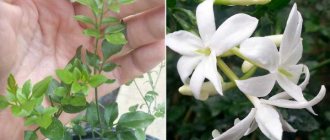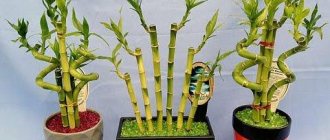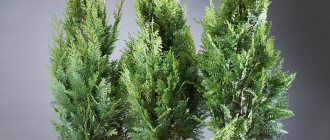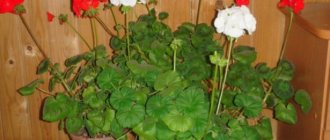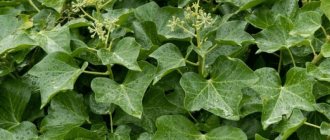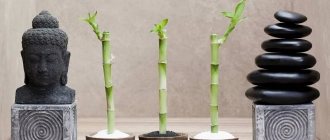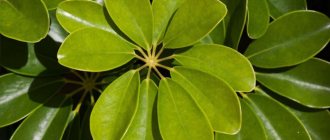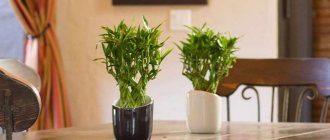Content
- General information
- Types and varieties of bamboo
- Bamboo indoor care at home
- Growing bamboo in water or soil
- Watering bamboo
- Soil for bamboo
- Transplanting bamboo
- Fertilizer for bamboo
- Bamboo blossom
- Bamboo trimming
- Caring for bamboo in winter
- Bamboo from seeds at home
- Propagation of bamboo by cuttings at home
- Diseases and pests
- Why does indoor bamboo turn yellow?
- Bamboo in the house - signs and superstitions
- Conclusion
Reproduction
Dracaena Sandera does not reproduce . Generally, the easiest way to propagate a bamboo houseplant is through pruning. Both stems and strong shoots are suitable for this purpose.
The good thing about bamboo is that its stems can be shaped into intricate spirals. To do this, you will have to cut off the shoots; they are used to propagate the plant.
shoots of indoor bamboo can be placed in water until new roots appear. You can plant them immediately in the ground, but provide more intense lighting and abundant watering.
Less commonly used is propagation by dividing the root system . This procedure is undertaken while indoor bamboo is being planted. In this case, you can also put the new plant in water or plant it in the soil.
General information
Bamboo is a plant with a bare stem, which only has several branches with leaves on top. The trunk of bamboo can be either straight or curved in the form of a spiral. Most often, the domestic variety of bamboo has a green tint, but there are also types with golden foliage and stems.
The Chinese believe that bamboo brings good luck and material well-being. If you adhere to the philosophy of Feng Shui, then this plant should definitely appear in your home, as it will not only bring prosperity, but will also diversify your flower collection with exoticism and beauty.
Types of indoor bamboos
Low plants are most suitable for growing at home. These include the following types:
- Motley- has a dwarf shape and variegated leaves, can reach no more than 1 meter in height;
Variegated bamboo - Brilliant . This plant has a purple stem that can reach 3 meters;
- Kumasaza. This species has a peculiar shape with a zigzag-shaped stem and looks like a dwarf bush;
Bamboo Kumasaza - Multilayer is a tall plant that can reach a height of 4 meters. The most suitable place for growing it is in rooms with high ceilings;
- Dracaena (also called lucky bamboo or lucky bamboo)- has a beautiful appearance and stems that intertwine;
- Bluish is a dwarf plant with variegated leaves. It reaches a height of no more than 50 centimeters, so small pots are used to grow it.
Types and varieties of bamboo
Indoor bamboo is a miniature plant with a smooth or spiral-shaped bare trunk with shoots and leaf blades at the top. Bamboo leaves are hard and glossy. They have an elongated lanceolate shape and a light green tint. At home, the plant rarely blooms, but if this happens, it throws out a long arrow with white, pleasantly smelling inflorescences. Peduncles appear in mid-summer.
Lucky bamboo is an evergreen semi-shrub perennial with a bare trunk, on the top of which leafy shoots grow. The leaf blades are hard and dense, with a rich green tint. The plant blooms extremely rarely. Flowering time occurs in mid-summer.
Common bamboo - bamboo of this species grows up to 20 meters in the wild. The thick, knotty stem has a bright yellow hue with green stripes and rich green glossy, elastic leaf plates. This plant rarely blooms. There are no seeds. It is propagated by bush division.
Multiple bamboo is the natural habitat of the plant in Nepal and the Himalayas. This type of bamboo grows in the form of a bush, consisting of individual plant trunks. This variety can grow up to 40 meters in length and has a thick, flexible and slightly gnarled stem. The leaf blades are hard, glossy, dark green. In nature, the plant blooms extremely rarely and often dies after that.
Bamboo Bloated
This type of indoor plant can grow up to 300 centimeters in length. It has thick, gnarled, dark green stems with thin branches and lush, green, glossy foliage. Bamboo does not bloom indoors, but it has excellent decorative properties.
Oldhamii Bamboo – This variety is known as giant bamboo. This plant is very popular in the USA. The bamboo stems are dark green in color and slightly knotty. They are elastic and can reach a height of up to 40 meters. Bamboo branches are short with lush, green, glossy leaf blades. The plant blooms extremely rarely, since flowering greatly depletes it and leads to death.
Blumeana bamboo is the natural habitat of this plant in tropical Asia and the Philippines. This type of bamboo can be compared to blackthorn. It can grow either as a bush or as single individuals. The stems of bamboo are thin gray-green. They bear branches with dark green foliage and small spines. Spiny bamboo does not bloom or bear fruit.
Tulda bamboo – grows in Indochina, Tibet and Iraq. Its stems are used to make paper. Young bamboo trunks are bright green, but after several years they become light gray and knotty. The trunk is covered with sparse thin branches with green foliage, which become denser towards the top of the trunk. In rare cases, bamboo throws out a flower shoot, which is covered with white, pleasantly smelling inflorescences. However, most often, flowering leads to depletion of the plant and its possible death.
Bamboo Longispiculata is a plant native to Bangladesh and Australia. Bamboo reaches a height of 8 to 15 meters. The trunk of the evergreen plant is almost bare, knotty, and of a rich green hue. A large number of shoots are formed closer to the top. They are covered with tough, sharp, green leaf blades. Only mature plants bloom, after which they often die.
Houseplant bamboo (48 photos): care and propagation
Indoor bamboo is an exotic plant that has an original and attractive appearance.
The houseplant bamboo is an evergreen, perennial, with a green, fleshy trunk, on which lance-shaped leaves are located on top. In nature, it can reach a height of up to several meters; at home, its height is usually limited, not allowing it to grow above 1 m - a plant that is too tall loses its decorative appeal, unless we are talking about some very elegant trunk shape.
In fact, the indoor plant, which we usually call “indoor bamboo,” only looks like real wild bamboo in appearance. But in fact it is called Dracaena sandera and is one of the types of shrubby dracaenas. In cultivation it blooms extremely rarely, with small white flowers that have a sweetish aroma. Indoor bamboo is valued for its decorative appearance, attracting with its green foliage and the ability to form an unusually shaped trunk. And also, according to Feng Shui, it brings good luck and attracts money to the house.
Dracaena Sandera in the interior
Bamboo will serve as an excellent decorative element
Ball-shaped flowerpot with Dracaena in modern design
Indoor bamboo: care and propagation
As a houseplant, bamboo is not very demanding; caring for it is relatively easy. It is very important for him to choose the right lighting - he loves bright, but diffused light, while his leaves do not tolerate direct rays of the sun - they turn yellow and can wither. The best place for it is east or southeast windows. If the leaves begin to turn yellow, then one of the reasons may be excessive amounts of light; in this case, the plant can even be moved to partial shade
Bamboo indoor care at home
Growing bamboo at home is not difficult, the main thing is to follow a number of rules and then you will be able to grow a healthy and beautiful plant that will become a real pearl of your flower collection.
Dracaena sandera can be grown both in soil and in water. Wide, slightly flattened pots, similar to bowls, are suitable for bamboo. The plant should be properly fertilized, watered and yellow leaf blades removed; if these rules are not followed, it may die.
Bamboo is a very light-loving crop. Light affects not only its growth and development, but also the color of the leaves and the height of the stems. Despite the fact that dracaena loves light, it should be protected from direct sunlight to avoid burns.
However, lack of light also negatively affects the plant, it becomes dull and slows down growth. Bamboo, deprived of solar energy, begins to reach for the sun, its stems become crooked and unattractive, and its leaves become faded and turn yellow.
Dracaena Sander requires moderate temperature conditions. The plant does not like drafts. For its normal growth, the temperature should range from 18 to 30 degrees. Temperature readings should not deviate from the norm, otherwise the bamboo may get sick.
Humidity, as well as temperature, should be moderate. In the hot season it should be 50%, and in the cold season 35%. To ensure comfortable conditions, you need to place an air humidifier next to the dracaena, and also spray the leaf plates with a sprayer. If the plant does not have enough moisture, its trunks will begin to crack and the dracaena will dry out.
Dracaena is a member of the Agave family. It can be grown with care at home without any problems if you follow the rules of agricultural technology. You can find all the necessary recommendations in this article.
Indoor bamboo: general information
Indoor bamboo does not require complex care; if the growing requirements are met, it can grow up to 25 cm in length.
If the culture is kept in a liquid medium, then it needs to be changed every 12-14 days. The liquid is pre-settled.
Dracaena bamboo
Use for interior decoration
Specialists use culture to complete the main interior. It easily combines with ceramic figurines and dishes, allowing you to create a unique style in the room. The plant does not require a certain air humidity and can be installed in any corner, even a dimly lit one.
Specimens are grown in soil or liquid and are suitable for creating an Asian-style effect. Medium-sized individuals are used as a living wall - to divide the room into zones.
For reference! Why is it better to replant the plant in a substrate after purchasing it at a flower shop: this will increase its chances of survival.
Bamboo in the interior
The magical properties of indoor bamboo
According to beliefs, bamboo at home can influence certain aspects of life. Magical properties depend on its exact location in the apartment:
- in the southeast corner - attracts financial well-being;
- eastern part - helps to achieve family harmony, get rid of quarrels and mistrust;
- southwestern - will evoke a romantic mood and improve relations between spouses.
Important! Installation of a flowerpot with bamboo must be carried out strictly according to Feng Shui
Briefly about the history of appearance
Under natural conditions, the culture is found in tropical forests of Asian, Australian, African and South American lands. The shrub was widely used as a building material or medicine. Some varieties were used for food.
Dwarf subspecies
The modern world has preferred to use bamboo in interior design. The flexible trunk allows you to create decorative elements from it, form a living wall - if necessary, divide the space into several small corners.
Growing bamboo in water or soil
As mentioned above, the plant can be grown both in water and in soil.
When growing dracaena in the ground, you should pay attention to the pot for planting, since the size and height of the bamboo will depend on how freely the root system grows in the container.
Since the plant is usually planted in small pots, bamboo stems do not grow tall, and they are also thin and less knotty than tall bamboo. To achieve miniaturization, dracaena should be replanted every three years, completely changing the soil.
The soil for the plant must be breathable with good drainage. Watering dracaena in the ground should be moderate, but you should not over-water it, as this will lead to rotting of the root system and death of the plant.
You can also grow bamboo in water or hydrogel. But in this case, it should not be planted in an ordinary pot, but in something like a large test tube or glass vase. To plant a plant in water, the roots should be washed and inspected for damage. Then the plant needs to be moved into a glass container and carefully filled with pre-boiled pebbles.
Next, you should pour settled or distilled water into the pot. It will need to be changed once every two weeks; if an unpleasant odor appears, then more often. Bamboo needs to be fertilized once a month.
When using hydrogel, the plant must be placed in a container for its further growth, pour the hydrogel into it and fill it with distilled water. It is best to choose a gel with small granules, as it will not allow the root system to be exposed and it will not dry out.
Caring for dracaena in hydrogel is simple. It is enough to add settled water to the container once every few weeks and feed the plant once every six months.
Indoor bamboo - how to care for it properly
When purchasing this plant, you need to know about the features of growing bamboo at home:
- Appropriate place. The room in which the flower will be located should be light and warm. It is not advisable to place the plant near heating devices, as the air there will be too dry;
- Soil . For growing, it is better to use organically enriched soil, which must be constantly fertilized. To do this, you can use special mixtures containing phosphorus and nitrogen. In summer, fertilizing is done once every three weeks; in winter, its amount is reduced;
- Watering . Household bamboo should be watered moderately, while ensuring that it does not flood. If there is an excess of water in the root system, the process of rotting may begin, which will lead to the death of the flower. To avoid this, drainage is made at the bottom of the pot. Lack of water can also adversely affect the plant. Curled leaves are a sign that watering is needed. The air near the plant must be periodically humidified.
Watering bamboo
Dracaena needs regular watering, but it will depend on where exactly the plant is grown. If it grows in water, then the liquid must cover the roots. The water in the container with bamboo should be changed to distilled water every week.
Bamboo in the ground should be watered once every three days, and spraying should also be carried out at the same time interval. Even if the top layer of soil has dried, there is no need to increase watering; you must adhere to the specified interval so as not to cause rotting of the root system.
Video: planting and caring for decorative bamboo
Dracaena Sandera or Lucky Bamboo is a fairly common indoor plant. It is believed that indoor luck bamboo can bring good luck and wealth to its owners.
Being a very unpretentious plant, bamboo can grow indoors for many years, growing up to 2-3 meters in size with proper care. At the same time, Sander's dracaena is very simple and easy to propagate at home from lateral and apical shoots, of which dracaena produces a large number.
So, we present to you step-by-step instructions with photos for propagating lucky bamboo (Dracaena Sander) at home.
- We choose healthy bamboo stems with shoots 10-15 cm long. It is very easy to identify a healthy stem - it is green and hard. If the stem turns yellow, darkens, or is soft to the touch, it is best not to use it for propagation. An example of healthy stems can be seen in the photo:
Next, remove excess leaves from the stems. It is best to leave only the top few leaves on the shoot. This will allow the bamboo to devote all its energy to root growth.
Cut off the shoot from the main stem. The easiest way is to cut it along the top edge of the main bamboo stem (see photo). It should be noted that the cut shoots must have at least one node (a thickening on the dracaena trunk), from which the roots of a new plant will then grow.
We place the cut off shoots of Dracaena Sandera in a container of water so that they take on new roots. This is usually not a quick process and can take two to three months. In this case, you should regularly change the water in the container to avoid the death of the plant. In this case, the water should be purified as best as possible (after the filter).
If you want new shoots to form on the old stem, then you need to cut it 1-2 cm below the cut shoot, but to the first node on the stem. It is from this node that a new bamboo shoot is formed after 1-2 months.
To prevent rotting of the top of the cut dracaena stem, it is necessary to treat it with wax. To do this, take an ordinary wax candle, melt a small piece of wax over the fire (it is best to do this in a tablespoon), and then lower the top of the plant into it. You should not keep it in wax for a long time, a couple of seconds is enough. After this, the top will be covered with a thin layer of wax, which will give it a good appearance and prevent it from drying out and various types of infections and bacteria getting into it.
Reproduction of bamboo at home is completely different from what its wild namesake needs. The difference lies in the fact that they are not related. The indoor beauty is not a grass. This is a type of such a common flower for home use as dracaena.
It is difficult to imagine that a bare stem with several shoots and leaves, growing straight or twisting in a spiral, can be propagated in any way. And yet it is so. Otherwise, flower nurseries could not boast of the diversity of this species. Learning the technique is easy and possible.
Soil for bamboo
Dracaena Sandera will grow much better in soil than in water. This feature is due to the fact that bamboo does not really like it when the root system is in liquid for a long time, and water does not stay in the ground for long.
You can choose any soil mixture for growing bamboo, the main thing is that it is loose and allows water and air to pass through well. In a flower shop, you can ask the seller to select a suitable soil or make it from washed sand and 1/3 peat moss.
In general, any well-draining soil with an acidity between 5.5 and 6.5 pH will do. After planting the plant, the soil should be lightly pressed to remove air and watered.
Transplanting bamboo
Replanting should be done in the spring every year. If a gardener grows large varieties of plants, then they need to be replanted every three years. It is very important to choose the right pot for replanting. The root system should not come into contact with its walls; there should be a distance between them of 5 to 7 centimeters. During replanting, you should change not only the container, but also the soil mixture due to the fact that it loses its nutritional properties over the course of a year.
When the dracaena is four years old, the frequency of transplantation should be reduced to once every three years. The soil mixture for bamboo should consist of either loam and humus, or moss and washed sand. Drainage is also a very important parameter when replanting; it should be placed at the bottom of the pot in a layer of 3 centimeters.
After transplantation, the plant acclimatizes for one and a half months, after which it begins to develop as usual.
Features of growing indoor bamboo
• Considering the increased requirements of this plant for air humidity, pots or vases with it should not be placed near sources of any type of heating, especially electric.
• 25 warm degrees is considered comfortable for growing bamboo at home, with a small temperature range
• Like many other indoor plants, bamboo needs mineral nutrition. To keep the plant healthy and the foliage juicy and lush, it is necessary to add fertilizers containing phosphorus and nitrogen to the soil of the container where it grows in proportionate proportions.
• When rooting bamboo or replanting it in fresh soil, the plant can be fertilized only after its complete adaptation and obvious growth dynamics.
Bamboo is grown at home in different ways:
• in a container with soil for dracaenas;
The choice of growing method remains up to the grower, but you should immediately warn that varnishes and hydrogels are quite expensive for the reason that they need frequent replacement due to the loss of their original properties. If you keep bamboo stems in them longer than their intended shelf life, the plant will begin to wither.
Growing bamboo in a container with soil:
Most of all, despite all the unpretentiousness to soil quality, a soil mixture for dracaenas is suitable for bamboo. The planting container should be spacious, taking into account the rapid growth of its root system. Young specimens of indoor bamboo need to be replanted into a larger pot annually, and mature specimens - once every 3 years. Especially new plantings should be kept moist for 2 weeks. In further caring for them, do not allow the soil to dry out.
Fertilizer for bamboo
Dracaena sandera should be fed with both mineral and organic fertilizers. It is best to buy fertilizer at a flower shop intended for dracaenas; it is ideal for bamboo, as it will be rich in the substances it needs.
In autumn and winter, fertilizing should be reduced to 1 time. In the warm season, bamboo needs to be fed once a month.
Bamboo blossom
The plant blooms once in its life. Since this process takes almost all the dracaena’s strength, most often it dies after this. However, it should be noted that indoor bamboo blooms extremely rarely. If this happens, the gardener notices an arrow on which, over time, white inflorescences with a very pleasant aroma appear.
Observations have shown that most often flowering occurs in the summer. If the bamboo still blooms, but the gardener does not want the plant to die, the flower shoot should be carefully removed and the cut area should be treated with charcoal.
Bamboo trimming
Bamboo tolerates pruning well, so the grower can shape it the way he wants. However, pruning and shaping should only be done when the plant has taken root and is completely healthy.
The procedure is carried out as follows:
- First, dry and excess stems located at ground level are removed.
- The stems are then fixed at a certain height and cut above the branching point. This must be done so that the stem stops growing upward.
- At the end, to give the plant a decorative appearance, you need to remove excess shoots.
If the grower wants the plant to grow vertically, he should regularly thin out the branches. Dracaena Sandera can be either straight-trunked or have a spiral-shaped trunk, everything will depend on the type of bamboo.
Caring for bamboo in winter
With the onset of winter, bamboo enters a dormant period, which means caring for the plant changes slightly. This concerns watering; it should be carried out once every five days, combining moisture with spraying.
The temperature in winter should not fall below +18, and humidity - below 35%. You should also provide additional lighting to the dracaena by purchasing a phytolamp for it. At the end of the winter period, bamboo care returns to normal.
Why does indoor bamboo sometimes turn yellow?
Despite the fact that the plant is considered unpretentious, sometimes its leaves may turn yellow. There may be several reasons for this:
- The plant is in direct sunlight;
- Fungal disease. In this case, the affected leaves must be removed;
- Dry air. It is necessary to periodically spray the leaves of the flower;
- Excessive or insufficient fertilizer addition. It will be enough for bamboo to feed once a month.
Bamboo is a beautiful house plant. Even a novice florist can organize proper care for it. A well-groomed, healthy plant can become a decoration for any room. In addition, every flower lover will be happy to receive a gift in the form of homemade bamboo.
Watch a video about caring for Bamboo of Happiness (bamboo Lucky):
Bamboo from seeds at home
Dracaena Sander is propagated by seed, cuttings and apical shoots. It is extremely difficult to propagate bamboo using apical shoots, especially if the grower does not have experience in this. The same applies to the seed method.
You can grow a plant from seeds in open ground; it is almost impossible to propagate cultivated varieties indoors. The chances of germination are extremely low. In addition, sowing seeds, the appearance of sprouts and caring for them is a labor-intensive and very lengthy process. Therefore, gardeners prefer to propagate bamboo using cuttings. This method is the simplest and most accessible.
Trimming and propagating bamboo in water
If the bamboo has grown too much and no longer looks attractive, then pruning should be done. It is done with special scissors, above the knots, otherwise the cut will be ugly.
Pruning can be done annually, trimming long shoots on all sides, and if necessary, removing outer canes at ground level.
By removing side shoots from the desired sides, you can model the shape and appearance of bamboo as you wish. Pruning can also be used to propagate bamboo. In this case, either cut off the top cuttings and root them in water, or cut the stem into several parts, lubricating the cuts with soft, but not hot, wax. Under no circumstances should yellowed areas of bamboo be used for propagation. If there are no shoots, then you can cut the top and after such an operation a shoot should grow, but if it does not appear, then repeat pinching the stem.
Propagation of bamboo by cuttings at home
Dracaena should be propagated by cuttings in the spring. For planting, it is necessary to use young branches that appear on a plant that has reached maturity. Planting material should be separated from the stem and planted in the ground so that it takes root.
The soil mixture for rooting should be the same as for planting the plant. Since bamboo grows very quickly, roots will appear within a month. The pot for cuttings should be spacious and medium in height, since after some time it will be completely filled with the roots of the planting material.
To make propagation easier, it is often combined with replanting mature bamboo, which is carried out once a year. The growing season is not only a favorable time for transplantation, but also for cuttings. Also, do not forget that after transplanting the cuttings into the ground, they should be carefully looked after in order to avoid problems with the growth and development of young plants in the future.
Diseases and pests
Bamboo can only get sick if it is not cared for properly. If dark spots begin to appear on the leaf blades of the plant , then most likely the dracaena began to develop a disease of fungal etiology, which was caused by waterlogging of the soil. To cope with it, it is necessary to treat the plant with a special fungicide, reduce watering and ventilate the room more often.
Slow plant development and yellowing of the stem or leaves may indicate a lack of nutrients. In this case, bamboo can be helped by correct and dosed feeding with a special fertilizer, which can be purchased at a flower shop.
If the gardener notices that the leaf plates of the dracaena have begun to crumble, darken and become soft , this means the plant is kept at the wrong temperature. The normal temperature for growth and development is considered to be 18-30 degrees.
The plant can also be threatened by pests such as aphids and spider mites. If the gardener notices cobwebs or stickiness of leaf blades , he should carefully examine the dracaena for the presence of these insects. If they are detected, it is necessary to remove damaged leaves and spray the plant with the Aktara insecticide according to the instructions on the package.
Proper care of bamboo will completely eliminate the occurrence of pests and diseases listed above.
Why does indoor bamboo turn yellow?
Dracaena Sandera is an evergreen plant that periodically sheds its leaves. First, the leaf blades turn yellow and then fall off, and this is absolutely normal. Most leaves fall in the spring. However, the natural feature of the plant does not always lead to leaf fall.
Yellowing of bamboo foliage can occur as a result of:
- Lack of nutrients in soil or water;
- Excessive application of fertilizers;
- Lack of moisture and light;
- Insufficient drainage;
- Incorrect temperature conditions;
- Low air humidity;
- Drafts;
- Watering with unsettled water.
If no violations were made in caring for the plant, then the yellowing is the preparation of the bamboo for shedding old foliage, which will soon be replaced by new ones.
Is it possible to trim indoor bamboo?
Indoor bamboo most often refers to the Dracaena sandera plant. Paradoxically, this flower has nothing in common with real bamboo, except for its external similarity. This plant is also known as Lucky Bamboo, Chinese Bamboo and Dragon Tree.
The indoor flower received such names for a reason. The Chinese treat it very respectfully, as they believe that the plant has magic.
Feng Shui pays special attention to this type of dracaena
According to the teachings of Taoist practice, it is a symbol of happiness, good luck and prosperity.
In addition to its exotic appearance and magical properties, the plant has another invaluable quality - unpretentiousness. By following all the simple care recommendations, even a novice gardener can cope with its cultivation.
Characteristics of bamboo and species diversity
Dracaena Sandera is an evergreen herbaceous perennial belonging to the genus Dracaena, family Asparagus. The hot African tropics are considered the birthplace of the flower. In its natural environment, the height of the plant reaches several meters. At home, the flower grows no more than 70-80 cm.
The stems are very similar to the trunks of real bamboo. They are bare and segmented. The stems have a bright light green color. Occasionally you can find dracaenas with dark green trunks.
The leaves are lanceolate in shape. They reach 25 cm in length and 3 cm in width. The texture of the plates is dense. The surface is glossy, as if covered with a thick layer of varnish. Dracaenas with light green stems have leaves of the same color. In rare dark green varieties they have a two-color color: on the dark green background of the plates there are white and yellow longitudinal stripes.
Only once in its entire life can it release a flower-bearing arrow with small white flowers collected in panicle inflorescences. Witnesses of this rare event note the pleasant aroma emanating from the flowers.
Unfortunately, flowering does not benefit the dracaena. As a rule, after this she dies.
Blooming Dracaena Sandera
Indoor flowers are actively used by designers as an element of room decor. Moreover, it fits equally harmoniously into the interior of both a cold office and a cozy bedroom. Often, the trunk of a plant is given a spiral or other unusual shape to increase its decorative value.
Secrets and difficulties of home care for indoor bamboo
Depending on where the plant is grown - in soil or in water, there are 2 options for caring for Sander's dracaena. In addition, this species has a weak rest period, which begins in mid-autumn and continues until spring. Caring for dracaena during the dormant period and during the growing season is different.
Growing and care in water
Bamboo can be grown in water. This foundation promotes rapid and harmonious plant growth. For bamboo, capacity is not of fundamental importance. But it looks most impressive in transparent vases or glasses. To increase the decorative effect, you can place several plants at once in a glass pot, tying them with a ribbon of a contrasting color.
Place some pebbles at the bottom of the flowerpot. First you need to wash it thoroughly, then boil it. The bamboo is freed from the old soil, the roots are washed. Growing in water is only suitable for healthy plants. If root rot is detected in dracaena, water will only contribute to its rapid development. Healthy bamboo is placed on pebbles and filled with water.
For cultivation, only soft water is used. You can use distilled or settled rainwater. The use of household water is unacceptable, even if it has been previously filtered.
The water is replaced with fresh water weekly. Every 2-3 months, when changing the water, mineral fertilizers are applied.
Bamboo can also be grown in hydrogel. It is advisable to use small granules. The plant is placed in hydrogel and filled with water. It is necessary to periodically add fresh water. Feeding is introduced every six months.
Landing in the ground
Dracaena is not picky about soil. Its only requirement is good air exchange. Therefore, the flower is grown even in universal soil. You can prepare the soil yourself. To do this, you need to mix the following components:
- turf soil – ½ part;
- leaf soil - ¼ part;
- peat – ¼ part.
The bottom of the pot must be lined with a good drainage layer of medium-sized materials. Without drainage, moisture will stagnate, causing rot to develop.
Bamboo in the house - signs and superstitions
Bamboo is highly valued in China due to a number of its magical properties. According to Feng Shui philosophy, the plant brings good luck, financial well-being and health to the house.
For Dracaena sandera to “work”, it should be placed in the south-eastern part of the home. However, if there is little light there, then it is necessary to additionally illuminate the bamboo using a phytolamp, otherwise it may simply die. If a florist wants to attract love into his life, he should place bamboo in the bedroom; if he wants to confidently walk up the career ladder, he should place dracaena in the office.
The number of bamboo stems also determines its influence on a particular area of human life. A plant with three stems brings good luck in all endeavors. Bamboo with 5 stems can improve personal life, and dracaena with 7 stems will make its owner healthy and successful. If a gardener wants to improve all aspects of life, he should get a dracaena with 21 stems.
To enhance the magical properties of bamboo, it must be supplemented with a three-legged frog with a coin in its mouth or a special Chinese vase depicting the sacred animals of the Land of the Rising Sun. The frog should be placed in close proximity to the plant, but only not high, otherwise it will “work” in the opposite direction, bringing failure and poverty.

